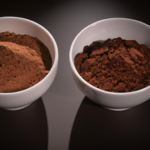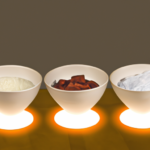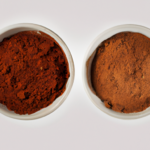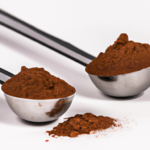Raw Food Ingredients
What Does Non Alkalanized Raw Cacao Powder Mean
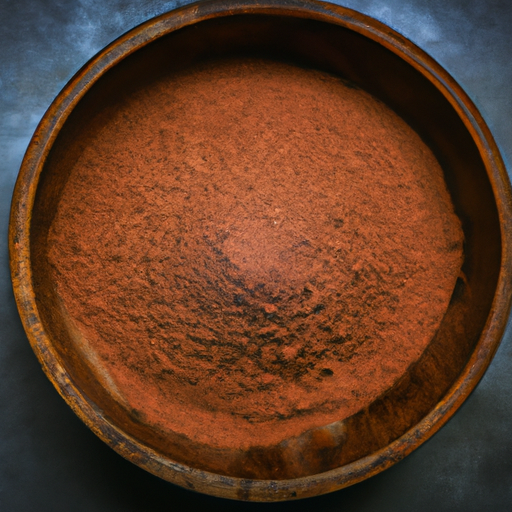
I know you may be wondering – what exactly is ‘non-alkalized raw cacao powder’? I can assure you, I was just as perplexed when I first encountered this term. However, delving into the realm of cacao has been a enlightening experience.
So, here’s the deal: non-alkalized raw cacao powder is essentially the purest form of cacao you can get your hands on. It hasn’t undergone any sort of alkalization process, which means it retains all of its natural goodness.
But why does that matter? Well, it turns out that the alkalization process alters the flavor, texture, and even the nutritional profile of cacao. By opting for non-alkalized raw cacao powder, you’re getting a product that’s bursting with antioxidants, minerals, and a rich, complex flavor.
Plus, it opens up a whole new world of culinary possibilities. So, if you’re ready to take your cacao game to the next level, buckle up because we’re about to explore everything there is to know about non-alkalized raw cacao powder.
Key Takeaways
- Non-alkalized raw cacao powder is a healthy addition to any diet.
- It is packed with nutrients and antioxidants.
- Non-alkalized cacao powder provides higher levels of antioxidants and nutrients compared to alkalized cacao powder.
- Some potential benefits of non-alkalized raw cacao powder include antioxidants, enhanced mood and energy, improved cardiovascular health, and rich nutrients.
The Origins of Cacao and Its Processing Methods
The journey of cacao begins in the lush rainforests of South America. Here, the precious cacao beans are carefully harvested and undergo a series of traditional processing methods. These methods ultimately transform the beans into the delightful non-alkalized raw cacao powder.
Cacao farming practices play a crucial role in ensuring the quality of the beans. Farmers employ sustainable techniques, such as shade-grown farming, which protects the delicate cacao trees from harsh sunlight.
After harvesting, the cacao beans are fermented and dried. This crucial step allows the beans to develop their distinct flavors. Once fermented and dried, the beans are then roasted and ground into a fine paste.
This paste is then pressed to separate the cocoa solids from the cocoa butter. This separation process results in the creation of cacao powder. The cocoa solids are what give the powder its rich flavor, while the cocoa butter adds a smooth and creamy texture.
Understanding alkalization and its effects on cacao is essential for appreciating the unique characteristics of non-alkalized raw cacao powder. Alkalization is a process that involves treating the cocoa beans with an alkaline substance, such as potassium carbonate. This process can alter the flavor and color of the cacao powder, giving it a milder taste and a darker appearance.
By choosing non-alkalized raw cacao powder, you can experience the true essence of cacao in its purest form. The natural flavors and vibrant colors of the cacao beans are preserved, providing a more intense and complex taste experience.
Understanding Alkalization and Its Effects on Cacao
Understanding alkalization and its effects on cacao is crucial in making informed choices about which type of cacao powder suits individual preferences and dietary needs. Alkalization is a process that alters the natural state of cacao, potentially changing its effects on the body. This process involves treating cacao powder with an alkaline substance, typically potassium carbonate, to modify its flavor, color, and texture.
One of the primary effects of alkalization is the reduction of cacao’s acidity, resulting in a less bitter and more mellow taste. This change in flavor can be desirable for individuals who prefer a smoother and less intense cacao experience. In addition to altering the taste, alkalization also affects the color of cacao. This process darkens and enriches the color of cacao powder, making it visually appealing and enhancing the appearance of food products that contain cacao.
While alkalization can enhance the taste and appearance of cacao, it is important to understand the differences between non-alkalized and alkalized cacao powder. Non-alkalized cacao powder retains its natural acidity and flavor profile, providing a more intense and complex taste. On the other hand, alkalized cacao powder offers a milder and less acidic flavor. The choice between these two types of cacao powder depends on personal preferences and dietary considerations.
In the subsequent section, we will explore the differences between non-alkalized and alkalized cacao powder in more detail, highlighting their distinct characteristics and potential uses.
Non-Alkalized vs. Alkalized Cacao Powder: What’s the Difference?
Explore the contrasting characteristics and effects of alkalized and non-alkalized cacao powder to better understand which option suits your taste and dietary preferences.
-
Alkalized cacao powder undergoes a process called alkalization, where it is treated with an alkaline substance like potassium carbonate. This process reduces the acidity of the cacao, resulting in a milder flavor and darker color. However, it also diminishes some of the natural antioxidants and nutrients found in raw cacao.
-
Non-alkalized cacao powder, on the other hand, is made from raw cacao beans that have not been treated with alkaline substances. This means it retains its natural acidity, intense flavor, and nutritional value. It is rich in antioxidants, vitamins, and minerals, making it a popular choice among health-conscious individuals.
Understanding the origins of cacao cultivation and the history of cacao processing provides valuable insights into the differences between alkalized and non-alkalized cacao powder.
Moving forward, let’s delve into the health benefits of non-alkalized raw cacao powder.
Health Benefits of Non-Alkalized Raw Cacao Powder
Indulging in this dark delight can bring a slew of nourishing benefits to your well-being. Non-alkalized raw cacao powder, also known as natural or unprocessed cacao powder, is packed with nutrients and antioxidants that promote good health. It is important to note that non-alkalized cacao powder is different from its alkalized counterpart in terms of processing and health benefits. While alkalized cacao powder undergoes a process to reduce its acidity, non-alkalized cacao powder retains its natural acidity and therefore preserves more of its nutrients.
To give you a clearer picture, here is a table comparing alkalized and non-alkalized cacao powder:
| Alkalized Cacao Powder | Non-Alkalized Cacao Powder | |
|---|---|---|
| Processing | Treated with alkali | Unprocessed |
| Nutrient Content | Lower | Higher |
| Antioxidants | Decreased | Increased |
Non-alkalized raw cacao powder can be used in a variety of culinary applications, such as baking, smoothies, and homemade chocolate. However, it is important to note that excessive consumption of cacao powder, even in its non-alkalized form, may have health risks. Now let’s delve into the nutritional profile of non-alkalized raw cacao powder.
Nutritional Profile of Non-Alkalized Raw Cacao Powder
The nutritional profile of non-alkalized cacao powder is a rich blend of vitamins, minerals, and antioxidants that can enhance your overall well-being. Incorporating this superfood into your diet can provide numerous nutritional benefits. Here are five reasons why you should consider adding non-alkalized raw cacao powder to your pantry:
-
High in antioxidants: Cacao powder is abundant in flavonoids, which act as powerful antioxidants, protecting your body from free radicals.
-
Rich in vitamins and minerals: It is a good source of magnesium, iron, and zinc, essential for various bodily functions.
-
Boosts mood and energy: Cacao powder contains natural compounds that stimulate the production of endorphins and enhance mental focus.
-
Supports heart health: The flavonoids in cacao powder may help lower blood pressure and improve blood flow, reducing the risk of heart disease.
-
Versatile ingredient: Non-alkalized raw cacao powder can be used in a variety of recipes, such as smoothies, desserts, and even savory dishes.
Incorporating non-alkalized raw cacao powder into your diet can be a delicious and nutritious way to support your well-being.
How to Incorporate Non-Alkalized Raw Cacao Powder into Your Diet
One way to spice up your recipes and give them a healthy twist is by incorporating non-alkalized raw cacao powder. This superfood is packed with nutrients and antioxidants, making it a great addition to any diet. Here are some creative recipes using non-alkalized raw cacao powder:
| Recipe | Ingredients | Instructions |
|---|---|---|
| Cacao Smoothie Bowl | – Non-alkalized raw cacao powder – Frozen bananas – Almond milk |
1. Blend all ingredients until smooth. 2. Pour into a bowl and top with your favorite toppings like berries and nuts. |
| Cacao Energy Balls | – Non-alkalized raw cacao powder – Dates – Nuts – Coconut flakes |
1. Blend all ingredients in a food processor until well combined. 2. Roll into small balls and refrigerate for at least 30 minutes. |
| Cacao Avocado Mousse | – Non-alkalized raw cacao powder – Avocado – Maple syrup – Vanilla extract |
1. Blend all ingredients until creamy. 2. Serve chilled and garnish with fresh berries. |
While non-alkalized raw cacao powder has numerous health benefits, it’s important to be aware of potential side effects. Consuming large amounts may lead to digestive issues, increased heart rate, or migraines in some individuals. It’s always best to start with small amounts and monitor your body’s response.
Next, let’s explore where to find non-alkalized raw cacao powder and how to incorporate it into your diet seamlessly.
Where to Find Non-Alkalized Raw Cacao Powder
In my previous discussion about incorporating non-alkalized raw cacao powder into your diet, I provided some delicious and healthy ways to enjoy this superfood. Now, let’s talk about where to find non-alkalized raw cacao powder and the benefits of using it.
-
Health food stores: Look for specialty health food stores that carry a wide range of organic products.
-
Online retailers: Many online retailers offer a variety of non-alkalized raw cacao powder options, making it convenient to purchase from the comfort of your own home.
-
Farmers markets: Local farmers markets often have vendors who sell natural and organic products, including non-alkalized raw cacao powder.
-
Co-ops: Community food co-ops are known for their commitment to providing organic and sustainable products, making them a great place to find non-alkalized raw cacao powder.
Using non-alkalized raw cacao powder in your recipes can provide numerous benefits, such as higher levels of antioxidants and nutrients. Now, let’s move on to the next section where I will share some tips for storing non-alkalized raw cacao powder.
Tips for Storing Non-Alkalized Raw Cacao Powder
When it comes to keeping your non-alkalized raw cacao powder fresh and flavorful, here are some handy tips for proper storage. Firstly, it is important to store your cacao powder in an airtight container to prevent moisture and odors from affecting its quality. Secondly, keep it in a cool, dark place like a pantry or cupboard, away from direct sunlight and heat sources. This will help preserve its natural flavors and nutrients. Additionally, avoid storing it near strong-smelling foods, as cacao powder easily absorbs odors. Lastly, always use a clean, dry spoon when scooping out the powder to prevent contamination and clumping. By following these tips, you can ensure that your non-alkalized raw cacao powder stays fresh and vibrant, enhancing the taste and benefits of your recipes. Now, let’s move on to frequently asked questions about non-alkalized raw cacao powder.
Frequently Asked Questions about Non-Alkalized Raw Cacao Powder
Curious about the secrets behind that rich, velvety indulgence you adore? Dive into the delightful world of non-alkalized raw cacao powder and uncover the answers to your frequently asked questions.
-
The benefits of consuming non-alkalized raw cacao powder:
- Packed with antioxidants: Non-alkalized raw cacao powder is rich in flavonoids and polyphenols, which help fight free radicals and protect against oxidative stress.
- Enhanced mood and energy: The natural compounds in cacao can boost serotonin levels, promoting feelings of happiness and well-being.
- Improved cardiovascular health: Cacao powder contains heart-healthy nutrients like magnesium and potassium, which support a healthy heart and lower blood pressure.
- Rich in nutrients: Non-alkalized raw cacao powder is a good source of iron, calcium, and fiber, providing essential nutrients for overall well-being.
-
How to make homemade non-alkalized raw cacao powder products:
- Smoothies and shakes: Add a spoonful of non-alkalized raw cacao powder to your favorite smoothie or protein shake for a delicious and nutritious boost.
- Baked goods: Incorporate cacao powder into your homemade brownies, cookies, or cakes for a decadent chocolate flavor.
- Hot chocolate: Mix non-alkalized raw cacao powder with hot milk or plant-based milk for a comforting and healthy hot chocolate drink.
- Energy balls: Combine cacao powder with nuts, dates, and other ingredients to create tasty and energizing snacks.
Explore the world of non-alkalized raw cacao powder and enjoy its numerous benefits while creating delicious homemade treats.
Frequently Asked Questions
Does non-alkalized raw cacao powder have a different taste compared to alkalized cacao powder?
Non-alkalized raw cacao powder has a different flavor profile compared to alkalized cacao powder. It retains more of its natural bitterness and fruity notes. Additionally, non-alkalized cacao powder tends to have higher levels of antioxidants and nutrients.
Can non-alkalized raw cacao powder be used as a substitute for alkalized cacao powder in recipes?
Yes, non-alkalized raw cacao powder can be used as a substitute for alkalized cacao powder in recipes. It retains its natural taste and has the added benefits of higher antioxidants and nutrients.
Is non-alkalized raw cacao powder more expensive than alkalized cacao powder?
Non-alkalized raw cacao powder tends to be pricier than alkalized cacao powder due to its higher quality and more natural processing. However, the taste of alkalized cacao powder may be preferred by some individuals.
Are there any potential side effects or risks associated with consuming non-alkalized raw cacao powder?
I will discuss potential health risks and recommended dosage associated with consuming non-alkalized raw cacao powder. It is important to be aware of these factors to ensure safe consumption.
Can non-alkalized raw cacao powder be used for making hot chocolate or other beverages?
Non-alkalized raw cacao powder, like a burst of rich flavor, is ideal for baking. When it comes to beverages, however, alkalized cacao powder may be preferred as it dissolves more easily and has a smoother taste.
What is the Relationship Between the Taste of Raw Cacao Beans and Alkalanized Raw Cacao Powder?
The raw cacao beans’ flavor profile is complex and intense, featuring a combination of fruity, nutty, and earthy notes. When raw cacao beans are alkalized to create raw cacao powder, the taste becomes milder and less bitter, offering a smoother and more versatile flavor for various culinary applications.
Conclusion
In conclusion, non-alkalized raw cacao powder is a treasure trove of health benefits waiting to be explored. Its natural state ensures that you reap the maximum nutritional benefits, without any added processing.
Just like a hidden gem, this pure cacao powder brings a burst of flavor and richness to your recipes, making them truly irresistible.
So, go ahead and unlock the potential of this magical ingredient in your kitchen, and indulge in its goodness with every bite. Your taste buds will thank you for this delectable adventure.
Rachael, the Editor in Chief of RachaelsRawFood.com, is an inspiring and passionate individual who has dedicated her life to promoting the benefits of a raw food lifestyle. Known for her vibrant and energetic personality, Rachael has built a strong online presence that has transformed her personal journey into a thriving community of raw food enthusiasts.
Raw Food Ingredients
How Much Caffeine in Cocoa?
Not all cocoa products are created equal when it comes to caffeine content – discover which one might surprise you!

When evaluating the caffeine levels in cocoa, it’s important to recognize that dark chocolate contains around 43 mg of caffeine per 100 grams due to its high cocoa solid content. Dark chocolate has a higher caffeine content compared to milk or white chocolate. This means that consuming dark chocolate in moderation can assist in managing your caffeine intake. On the other hand, milk chocolate has around 20 mg of caffeine per 100 grams while white chocolate is caffeine-free. Cocoa powder, commonly used in baking and beverages, contains a substantial 230 mg of caffeine per 100 grams. Being aware of these distinctions in chocolates can help you make informed decisions about your caffeine consumption.
Key Takeaways
- Caffeine content in cocoa varies based on cocoa solid concentrations.
- Unsweetened cocoa powder can contain around 230 mg of caffeine per 100 grams.
- Roasting cocoa solids influences the final caffeine content in cocoa products.
- Dark chocolate, with high cocoa solid content, has more caffeine than milk chocolate.
- Moderate consumption of cocoa products helps manage caffeine intake.
Caffeine Content in Dark Chocolate
Dark chocolate boasts a caffeine content of approximately 43 mg per 100 grams, mainly deriving from its higher cocoa solid composition. When we indulge in this decadent treat, we aren't only savoring its rich cocoa flavor but also a subtle caffeine kick. Compared to milk or white chocolate, dark chocolate contains a higher amount of caffeine.
Please bear in mind that moderate consumption of dark chocolate can assist individuals in managing their caffeine intake effectively. The caffeine levels in dark chocolate are about one-fourth of what you'd find in a standard cup of coffee. So, if you're looking for a milder caffeine boost, a piece of dark chocolate might just do the trick without the jitters that sometimes accompany a strong cup of coffee.
Enjoy your dark chocolate in moderation, savoring both its taste and the gentle pick-me-up it provides.
Caffeine Levels in Milk Chocolate

Milk chocolate, known for its creamy texture and sweet flavor, contains a modest caffeine content of approximately 5.6 mg per ounce, as indicated by USDA data. Unlike dark chocolate, milk chocolate has a lighter color due to lower cocoa content, resulting in reduced caffeine levels.
The delightful creamy taste in milk chocolate comes from a harmonious blend of cocoa and milk powder. While dark chocolate boasts higher caffeine content, milk chocolate remains a popular choice for those seeking a sweet treat with minimal caffeine intake.
Caffeine Presence in White Chocolate
With its unique composition excluding cocoa solids, white chocolate stands out as a caffeine-free alternative to its darker counterparts. White chocolate is crafted from a blend of cocoa butter, milk powder, sugar, and vanilla, making it a delectable treat without the stimulating effects of caffeine. For individuals sensitive to caffeine, white chocolate offers a creamy texture and indulgent flavor without the worry of unwanted side effects. This makes it a popular choice for desserts among those looking to steer clear of caffeine in their sweet treats.
Compared to dark chocolate, which contains cocoa solids and hence caffeine, white chocolate provides a caffeine-free option for those seeking a more mellow indulgence. So, if you're in the mood for a luscious and smooth chocolate experience without the buzz of caffeine, white chocolate is the perfect choice for your next dessert delight.
Impact of Cocoa Solids on Caffeine

In determining the caffeine levels in cocoa products, the percentage of cocoa solids plays a significant role. Here are some key points about the impact of cocoa solids on caffeine content:
- Caffeine Derivation: The caffeine content in cocoa primarily comes from cocoa solids, making it an important factor in determining the overall caffeine levels in cocoa-based products.
- Dark Chocolate: Dark chocolate, known for its higher cocoa solid content, tends to contain more caffeine compared to milk or white chocolate varieties due to this higher concentration.
- Unsweetened Cocoa Powder: A 100g serving of unsweetened cocoa powder can contain around 230mg of caffeine, reflecting the impact of the high cocoa solid content in this form.
- Health Benefits: The roasting process of cocoa solids not only affects the flavor profile but also influences the caffeine content, contributing to the potential health benefits associated with consuming cocoa products like hot cocoa.
Comparing Caffeine in Different Chocolates
Comparing the caffeine content in different chocolates reveals varying levels based on their cocoa solid concentrations. Dark chocolate contains about 43 mg of caffeine per 100 grams, making it a stronger caffeinated option compared to milk chocolate, which only has around 20 mg per 100 grams.
Surprisingly, white chocolate, derived from cocoa butter, doesn't contain any caffeine at all. For those seeking a more potent caffeine kick, cocoa powder is the way to go, boasting a high concentration of 230 mg per 100 grams.
The amount of caffeine in chocolate products is closely linked to the cocoa solid content, with dark chocolate containing the highest levels. So, the next time you're craving a chocolate treat but also need a little energy boost, opt for dark chocolate to get the most caffeine per bite.
Frequently Asked Questions
Is There More Caffeine in Cocoa Than Coffee?
There's more caffeine in cocoa than in coffee. Cocoa powder packs 230 mg per 100 grams, surpassing most coffee varieties. Dark chocolate has even more caffeine due to higher cocoa content. It's a rich, unique energy source.
Is There a Lot of Caffeine in Hot Cocoa?
There isn't a lot of caffeine in hot cocoa. It depends on the brand and recipe. Starbucks hot chocolate has around 25 mg per serving, while basic mixes have about 5 mg. The amount of cocoa powder used influences the caffeine content.
Is There Caffeine in Hershey's Cocoa?
Absolutely, Hershey's Cocoa does contain caffeine, but it's not overwhelming. It adds a delightful hint of energy in each spoonful. Perfect for baking or a cozy cup of hot chocolate. Just the right amount!
Is Cocoa a Stimulant Like Caffeine?
Cocoa stimulates like caffeine due to its theobromine content. Decaf versions offer a solution for caffeine-sensitive folks. Options include regular cocoa with caffeine, Dutch-processed cocoa with less, and decaf cocoa with reduced caffeine while keeping healthful compounds.
What are the potential health effects of consuming high levels of caffeine in cocoa?
Unveiling cocoa caffeine levels can lead to potential health effects of excessive consumption. High levels of caffeine in cocoa may contribute to insomnia, nervousness, and fast heartbeat. It can also cause gastrointestinal discomfort and exacerbate anxiety disorders. Moderation in consuming caffeinated cocoa products is recommended for overall health.
Conclusion
To sum up, the caffeine content in cocoa varies depending on the type of chocolate. Dark chocolate typically has the highest caffeine levels, followed by milk chocolate and white chocolate. The amount of cocoa solids in the chocolate also affects the caffeine content.
Remember, just like different chocolates have different levels of caffeine, we all have unique strengths and abilities. Embrace your individuality and always aim for balance in everything you do.
Rachael, the Editor in Chief of RachaelsRawFood.com, is an inspiring and passionate individual who has dedicated her life to promoting the benefits of a raw food lifestyle. Known for her vibrant and energetic personality, Rachael has built a strong online presence that has transformed her personal journey into a thriving community of raw food enthusiasts.
Raw Food Ingredients
5 Key Differences: Caffeine Content in Cocoa Vs Coffee
Open the door to understanding the contrasting caffeine levels in cocoa and coffee, revealing surprising insights that will reshape your beverage choices.

When comparing the caffeine levels in cocoa and coffee, it is important to understand that cocoa generally has lower caffeine content than coffee. Dark chocolate contains approximately 12 milligrams of caffeine per ounce, while hot cocoa typically ranges from 5 to 10 milligrams per ounce. In contrast, brewed coffee can have significantly higher levels, varying from 95 to 165 milligrams per 8-ounce cup.
Cocoa is considered a milder option for individuals aiming to limit their caffeine intake, with theobromine providing a gradual energy increase. Meanwhile, coffee's caffeine content offers immediate alertness, and understanding these distinctions can help you select based on your preferred effects.
Key Takeaways
- Cocoa contains lower caffeine levels but compensates with theobromine for a gradual energy increase.
- Coffee has higher caffeine content, offering an immediate alertness boost and potentially higher metabolic rate.
- Theobromine in cocoa promotes relaxation, while caffeine in coffee provides intense alertness and mood fluctuations.
- Hot chocolate is a good option for reducing caffeine intake while still benefiting from theobromine effects.
- Understanding caffeine variances helps make informed choices for desired energy levels and mood effects.
Caffeine Levels in Cocoa Vs Coffee
When comparing caffeine levels in cocoa versus coffee, it's evident that cocoa generally contains lower amounts per serving. Dark chocolate, made from cacao beans, contains around 12 milligrams of caffeine per ounce, while a 1-ounce serving of hot cocoa mix typically has 5-10 milligrams. Even a 16-ounce serving of Starbucks hot chocolate only contains about 25 milligrams of caffeine.
On the other hand, coffee, when brewed, can range from 95 to 165 milligrams of caffeine per 8-ounce cup, depending on the type and brewing method. This significant difference in caffeine content between cocoa and coffee makes cocoa a milder option for those looking to limit their caffeine intake.
Impact on Alertness and Energy

Typically, the immediate alertness and energy boost from caffeine in coffee can last for hours. This surge in alertness is due to caffeine's stimulating effect on the central nervous system. On the other hand, cocoa contains theobromine, which provides a more gradual increase in energy levels. Unlike caffeine, theobromine doesn't cause sudden spikes and crashes, offering a smoother energy curve.
Coffee's caffeine content can temporarily boost the metabolic rate, potentially supporting weight management efforts. This increased metabolic rate can aid in burning calories and may contribute to weight loss when combined with a balanced diet and regular exercise. Additionally, theobromine in cocoa contributes to the thermogenic effect, leading to mild calorie burning in the body.
Both caffeine and theobromine can influence mood. Caffeine tends to provide a more intense and quick-acting mood elevation, while theobromine promotes feelings of relaxation and contentment. Understanding the differences in alertness, energy, metabolic effects, and mood enhancements between cocoa and coffee can help individuals make informed choices based on their preferences and wellness goals.
Metabolic Variances and Effects
Regarding metabolic variances and effects, the varying caffeine levels between cocoa and coffee play a significant role. When comparing the metabolic impact of caffeine in cocoa and coffee, it is crucial to note that cocoa contains lower levels of caffeine but compensates with theobromine, which aids in the thermogenic effect, promoting calorie burning and metabolic activity. On the other hand, coffee, especially brewed varieties, contains higher levels of caffeine, potentially providing a temporary boost to the metabolic rate, which could assist in weight management. While caffeine in coffee offers a quick energy surge, theobromine in cocoa leads to a more gradual rise in energy levels, avoiding sudden spikes and crashes. To summarize the metabolic differences, I've created a table below:
| Aspect | Cocoa | Coffee |
|---|---|---|
| Caffeine Content | Lower levels | Higher levels |
| Additional Component | Theobromine | Caffeine |
| Metabolic Impact | Thermogenic effect | Temporary metabolic rate boost |
| Energy Levels | Gradual rise | Quick surge |
| Weight Management | Aids in calorie burning | Potential assistance |
Mood Enhancement Disparities

In comparing the mood enhancement effects of theobromine in cocoa and caffeine in coffee, notable disparities emerge in their impact on mental well-being.
The theobromine found in cocoa promotes relaxation and contentment, offering a gradual rise in energy levels that leads to a gentle and long-lasting mood enhancement experience.
On the other hand, caffeine delivers an intense and fast-acting boost in alertness, providing immediate energy levels that can lead to abrupt spikes and crashes.
While both theobromine and caffeine uplift mood, theobromine's effects are characterized by a steady and gradual increase in energy levels, creating a sense of calm and contentment.
In contrast, caffeine's impact is more intense and temporary, resulting in rapid alertness but also the potential for fluctuations in mood. Understanding these differences can help individuals choose between cocoa and coffee based on their desired mood enhancement effects.
Health Implications and Considerations
Health implications and considerations surrounding caffeine consumption warrant close attention due to its potential impact on various aspects of well-being. When comparing a cup of coffee to hot chocolate, it's vital to note the amount of caffeine present.
While coffee contains much caffeine, hot chocolate has less caffeine but isn't entirely devoid of it. The main active ingredients in hot chocolate are theobromine and caffeine, where theobromine is a relative of caffeine and also has stimulant effects, although milder. If you're looking to reduce your caffeine intake, opting for hot chocolate over a cup of coffee can be a good choice.
Being mindful of the caffeine content in chocolate products is important, especially if you're sensitive to caffeine or belong to vulnerable populations like children or pregnant women. Understanding the caffeine levels in different beverages allows you to make informed decisions about your consumption for better overall health.
Frequently Asked Questions
Is There Caffeine in Coffee Vs Cacao Powder?
Yes, there is caffeine in coffee, with around 140 milligrams in a 12-ounce cup. On the other hand, cacao powder contains only about 12 milligrams per tablespoon, making it a great caffeine-free alternative for those seeking a milder boost.
What Is the Difference Between Cocoa and Coffee?
When comparing cocoa and coffee, cocoa offers a rich, chocolatey flavor and is packed with antioxidants and minerals. Coffee, on the other hand, provides a robust, bitter taste and a jolt of caffeine for that morning pick-me-up.
Why Is Cocoa Better Than Coffee?
I believe cocoa is superior to coffee because it offers a gentler energy boost, promotes relaxation and contentment, and provides sustained vitality without sudden crashes. Plus, dark chocolate's theobromine supports cellular health and tastes delicious.
How Much Caffeine Is in Cocoa Powder Vs Decaf Coffee?
In cocoa powder vs decaf coffee, cocoa has 12-26mg of caffeine per tbsp, while decaf coffee holds 2-5mg per 8-ounce cup. The choice hinges on desired caffeine levels and flavor. I prefer cocoa's lower caffeine content.
How does the caffeine content in hot chocolate compare to coffee?
Hot chocolate caffeine content is significantly lower than that of coffee. While an 8-ounce cup of hot chocolate contains about 5-10 milligrams of caffeine, the same size of coffee can have anywhere from 95-200 milligrams. It’s a notable difference for those looking to limit their caffeine intake.
Conclusion
To sum up, while cocoa and coffee both contain caffeine, the levels vary significantly. Cocoa generally has lower caffeine content compared to coffee, impacting alertness, energy levels, and mood enhancement differently.
It's crucial to keep these differences in mind when choosing between the two beverages for your daily consumption. Remember, moderation is key to maintaining a healthy balance in your caffeine intake.
So, whether you prefer a cup of cocoa or a mug of coffee, enjoy it in moderation for the best benefits!
Rachael, the Editor in Chief of RachaelsRawFood.com, is an inspiring and passionate individual who has dedicated her life to promoting the benefits of a raw food lifestyle. Known for her vibrant and energetic personality, Rachael has built a strong online presence that has transformed her personal journey into a thriving community of raw food enthusiasts.
Raw Food Ingredients
A Guide to Becoming a Good King
Kingship demands wisdom, fairness, integrity, courage, and humility – essential traits for a successful reign and prosperous kingdom." Keep reading to uncover the secrets of becoming a good king.

In order to be a good king, one must embody wisdom, fairness, integrity, courage, and humility to lead the kingdom with honor. Wisdom is essential for making important decisions, fairness ensures just treatment for all, integrity builds trust and respect, courage is crucial for facing challenges, and humility reminds us of our humanity. Historical kings such as Solomon, Arthur, David, Charlemagne, and Ramses II serve as role models for these leadership traits.
As a king, embracing challenges, understanding the world, seeking personal growth, and learning from the past are essential responsibilities. Developing leadership skills, making wise decisions, and prioritizing the well-being of the people are key to effective kingship. Every step on the path to becoming a good king is critical for a successful reign and prosperous kingdom.
Key Takeaways
- Embrace wisdom for informed decisions.
- Practice fairness for just treatment.
- Uphold integrity to earn trust.
- Show courage in facing challenges.
- Maintain humility for empathy and respect.
Qualities of a Good King
Being a good king requires embodying qualities such as wisdom, fairness, integrity, courage, humility, and compassion in decision-making and leadership. Power comes with responsibility, and as a king, it's essential to wield this power wisely. Wisdom is vital in making sound judgments that benefit the kingdom as a whole. Fairness guarantees that all subjects are treated justly and equitably, fostering a harmonious society. Integrity is the foundation of trust and respect, key elements in effective leadership.
Courage is necessary to face challenges and make difficult decisions, even when met with opposition. Humility reminds a king of his humanity and the importance of humility in interactions with all subjects. Compassion demonstrates a king's care and empathy towards his people, fostering a sense of unity and loyalty. Effective communication is crucial for conveying decisions, listening to concerns, and inspiring confidence in leadership.
Historical Kings as Role Models

King Solomon, renowned for his wisdom and leadership, stands as an exemplar among historical kings who serve as role models for future leaders. Looking at figures like King Arthur, known for his justice and valor in medieval legends, and King David, celebrated for his faith and courage in battle, we find lessons that transcend time. Charlemagne's legacy of military conquests and cultural revival, alongside Ramses II's grand building projects and military campaigns, offer diverse insights into effective kingship. Below is a table summarizing key attributes of these historical kings:
| King | Attributes |
|---|---|
| King Solomon | Wisdom, leadership |
| King Arthur | Justice, valor |
| King David | Faith, courage |
| Charlemagne | Military prowess, culture revival |
| Ramses II | Building projects, military campaigns |
Studying these historical figures can provide valuable lessons on the multifaceted qualities that make a great ruler.
Responsibilities of Kingship
Embracing challenges and living authentically are central to fulfilling the responsibilities inherent in kingship. As men aspiring to be good kings, it's essential for us to understand that the world requires leaders who are kind, humble, and committed to personal growth.
The journey to becoming a good king involves more than just wielding power and responsibility—it entails sacrificing comfort for growth and transformation. Seeking the ancient path of masculinity, as exemplified by figures like Morgan, teaches us the importance of humility, vulnerability, and character development.
In fulfilling the responsibilities of kingship, we're entrusted with power not for our own gain, but for the betterment of the world around us. Just as seeds need Good Soil to flourish, we must nurture our own growth to lead effectively.
Leadership Skills for Kings

Developing essential leadership skills is crucial for aspiring kings seeking to fulfill their responsibilities with humility, vulnerability, and a focus on character development. As you study the world around us, the power and responsibility of what kingship entails become clearer. Here are some key points to think about on your path to becoming a king:
- Embrace challenges and live authentically.
- Seek ancient paths of masculinity for guidance.
- Reflect on your identity, purpose, and ability to be entrusted with power for good.
- Sacrifice comfort for growth, transformation, and participation in universal creativity.
The journey of becoming a king isn't just about gaining authority but about understanding the remarkable fellowship of like-hearted individuals who share similar goals. Engage in group discussion questions, consider between-session personal study, and explore the depths of your masculine soul. This is the path to restoring what it means to be a true king.
Importance of Wise Decision-Making
Steering through the intricacies of leadership, especially in the domain of kingship, requires a sharp focus on the art of prudent decision-making. Wise decision-making is like the compass guiding the ship of leadership towards success.
Good kings understand that their choices impact not just themselves but also the lives of those they rule over. They prioritize the well-being of their people over personal gains, embodying the essence of true leadership.
Seeking counsel from trusted advisors and reflecting on core values are essential practices in the domain of wise decision-making. By embracing humility and self-awareness, kings can navigate the complex web of choices with clarity and integrity.
Just like a six-session video Bible study can guide individuals in restoring the heart, wise decision-making is essential for becoming the kind of leaders our world needs. Let's start on this journey of radical reconstruction, where every decision is a step towards being counted among the good kings of history.
Frequently Asked Questions
What Is the Becoming a King Guide?
The Becoming a King guide is a transformative resource created by Morgan Snyder to help men grow into responsible kings. It offers practical tools and profound insights to aid personal development and transformation.
What Are the Qualities of a Good King?
Being a good king means embodying humility, wisdom, and integrity. Prioritizing the well-being of my people, making decisions for the greater good, and showing courage, justice, and compassion in all actions. Seeking counsel and valuing diverse perspectives is essential.
What Makes a True King?
Beneath the crown lies a heart that beats with humility and a spirit that soars with honor. True kings are forged in the fires of challenge, embracing authenticity and growth to inspire others.
What Makes a Real King?
Being a true king means embodying humility, courage, and empathy. It's about serving others and leading with integrity. I endeavor to cultivate these qualities daily, embracing challenges and seeking growth in all aspects of my life.
How Can Sacred Cacao be Incorporated Into Kingship Rituals?
In kingship rituals, the sacred cacao ritual holds great significance. The ceremonial drinking of cacao symbolizes the divine connection between the ruler and the spiritual realm. It is believed to impart wisdom and strength, making it a crucial element in the coronation and leadership rites of many cultures.
Conclusion
To sum up, becoming a good king requires a combination of qualities, skills, and responsibilities. Remember, 'With great power comes great responsibility.'
By studying historical kings as role models, practicing leadership skills, and making wise decisions, one can aspire to be a just and effective ruler.
It's a challenging path, but with dedication and perseverance, anyone can endeavor to be a worthy leader for their kingdom.
Rachael, the Editor in Chief of RachaelsRawFood.com, is an inspiring and passionate individual who has dedicated her life to promoting the benefits of a raw food lifestyle. Known for her vibrant and energetic personality, Rachael has built a strong online presence that has transformed her personal journey into a thriving community of raw food enthusiasts.
-

 Health and Wellness2 months ago
Health and Wellness2 months agoDoes Eating Raw Food Help You Lose Weight? Discover the Truth
-

 Kitchen Essentials for Raw Food Preparation1 month ago
Kitchen Essentials for Raw Food Preparation1 month agoCan You Cook Raw Food in an Air Fryer? Discover the Possibilities
-

 Raw Food Recipes2 months ago
Raw Food Recipes2 months agoHow Much Raw Food to Feed Your Puppy: Essential Tips
-

 Raw Food Recipes2 months ago
Raw Food Recipes2 months agoHow to Defrost Dog Raw Food Properly
-

 Health and Wellness2 months ago
Health and Wellness2 months agoHow Long Does It Take Bacteria to Spread From Raw Food? Essential Info
-
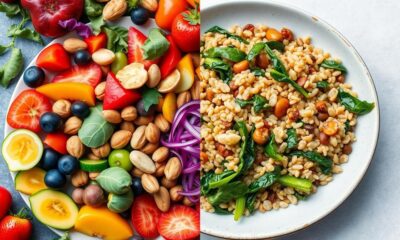
 Raw Food Recipes2 months ago
Raw Food Recipes2 months agoRaw Food Vs. Vegan: Which Diet Is Better?
-

 Raw Food Recipes2 months ago
Raw Food Recipes2 months agoIs Raw Food Good for Cats? Find Out Here
-

 Kitchen Essentials for Raw Food Preparation4 weeks ago
Kitchen Essentials for Raw Food Preparation4 weeks agoWhich Raw Food Should Be Stored Above? Essential Tips


